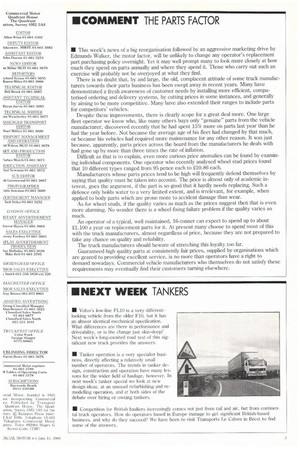INCOMMENT THE PARTS FACTOR • This week's news of a
Page 3

If you've noticed an error in this article please click here to report it so we can fix it.
big reorganisation followed by an aggressive marketing drive by Edmunds Walker, the motor factor, will be unlikely to change any operator's replacement part purchasing policy overnight. Yet it may well prompt many to look more closely at how much they spend on parts annually and where they spend it. Those who carry out such an exercise will probably not be overjoyed at what they find.
There is no doubt that, by and large, the old, complacent attitude of some truck manufacturers towards their parts business has been swept away in recent years. Many have demonstrated a fresh awareness of customer needs by installing more efficient, computerised ordering and delivery systems, by cutting prices in some instances, and generally by aiming to be more competitive. Many have also extended their ranges to include parts for competitors' vehicles.
Despite these improvements, there is clearly scope for a great deal more. One large fleet operator we know who, like many others buys only "genuine" parts from the vehicle manufacturer, discovered recently that he had spent 15% more on parts last year than he had the year before. Not because the average age of his fleet had changed by that much, or because his vehicles had required more maintenance for any other reason. It was just because, apparently, parts prices across the board from the manufacturers he deals with had gone up by more than three times the rate of inflation.
Difficult as that is to explain, even more curious price anomalies can be found by examining individual components. One operator who recently analysed wheel stud prices found that 10 different types ranged from 95 pence each to 210.86 each.
Manufacturers whose parts prices tend to be high will frequently defend themselves by saying that quality must be taken into account. The price is almost only of academic interest, goes the argument, if the part is so good that it hardly needs replacing. Such a defence only holds water to a very limited extent, and is irrelevant, for example, when applied to body parts which are prone more to accident damage than wear. As for wheel studs, if the quality varies as much as the prices suggest then that is even more alarming. No wonder there is a wheel fixing failure problem if the quality varies so much.
An operator of a typical, well maintained, 16-tonner can expect to spend up to about 21,100 a year on replacement parts for it. At present many choose to spend most of this with the truck manufacturers, almost regardless of price, because they are not prepared to take any chance on quality and reliability.
The truck manufacturers should beware of stretching this loyalty too far.
Guaranteed high quality parts at consistently fair prices, supplied by organisations which are geared to providing excellent service, is no more than operators have a right to demand nowadays. Commercial vehicle manufacturers who themselves do not satisfy these requirements may eventually find their customers turning elsewhere.




























































